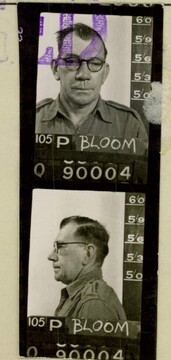BLOOM, Edward
| Service Numbers: | 381, Q90004 |
|---|---|
| Enlisted: | 1 May 1941 |
| Last Rank: | Private |
| Last Unit: | 1 Garrison Battalion (QLD) |
| Born: | BRISBANE, QLD, 26 February 1894 |
| Home Town: | Not yet discovered |
| Schooling: | Not yet discovered |
| Occupation: | Not yet discovered |
| Memorials: |
World War 1 Service
| 18 May 1916: | Embarked Private, 381, 41st Infantry Battalion, HMAT Demosthenes, Sydney | |
|---|---|---|
| 18 May 1916: | Involvement Private, 381, 41st Infantry Battalion, --- :embarkation_roll: roll_number: '18' embarkation_place: Sydney embarkation_ship: HMAT Demosthenes embarkation_ship_number: A64 public_note: '' |
World War 2 Service
| 1 May 1941: | Involvement Private, Q90004 | |
|---|---|---|
| 1 May 1941: | Enlisted | |
| 1 May 1941: | Enlisted Australian Military Forces (WW2) , Private, Q90004, 1 Garrison Battalion (QLD) | |
| 25 Feb 1946: | Discharged Australian Military Forces (WW2) , Private, Q90004, 1 Garrison Battalion (QLD) | |
| 25 Feb 1946: | Discharged |
Help us honour Edward Bloom's service by contributing information, stories, and images so that they can be preserved for future generations.
Add my storyBiography contributed by Aubrey Bairstow
Edward Bloom was a 21 year old labourer from Nerang on the Gold Coast. At the time the area was sparsely populated. The 41st Battalion was raised at Bell's Paddock Camp in Brisbane in February 1916 with recruits from Brisbane, northern Queensland and the northern rivers district of New South Wales. It formed part of the 11th Brigade of the 3rd Australian Division.
After training in Australia and Britain, the 41st Battalion arrived in France on 25 November 1916. It entered the front line for the first time on Christmas Eve and spent the bleak winter of 1916-17 alternating between service in the front line, and training and labouring in the rear areas.
The 41st had a supporting role at Messines on 7 June, captured its objectives at Broodseinde on 4 October with little difficulty, and was spared the carnage of Passchendaele on 12 October. It was some of the battalion's more "routine" tasks that proved its most trying experiences. At the end of June 1917, the 11th Brigade was ordered to establish a new front line west of Warneton, in full view of the Germans. Work carried on night and day under heavy shellfire and the period became known to the battalion as "the 18 days". The start of August found the 41st holding ground captured by two of its sister battalions in a feint attack on 31 July. Enduring continual rain, flooded trenches and heavy shelling many of the battalion's platoons dwindled from 35 men to less than ten.
In March 1918, the battalion was rushed south to France and played a role in blunting the drive towards the vital railway junction of Amiens. In April 1918 he suffered a wounding to his index finger. The nature and cause is not stated however it turned septic and necessitated him being returned to England for treatment. Scars were still visible when he enlisted in WW2.
The Allies launched their own offensive on 8 August 1918, and the 41st played an active role both in the initial attack and the long advance that followed throughout August and into September. The 41st participated in its last major action of the war between 29 September and 2 October 1918 as part of the Australian-American operation that breached the formidable defences of the Hindenburg Line along the St Quentin Canal. The battalion was out of the line when the war ended, and was disbanded in May 1919. He returned to Australia in June 1919 and was discharged in August of that year.
During World War Two he served in 1 Garrison Battalion from May 1941 until February 1946. By this time he was living at Capalaba. His service seems to be entirely Brisbane based. Any WW2 medal entitlement was not claimed by him.









